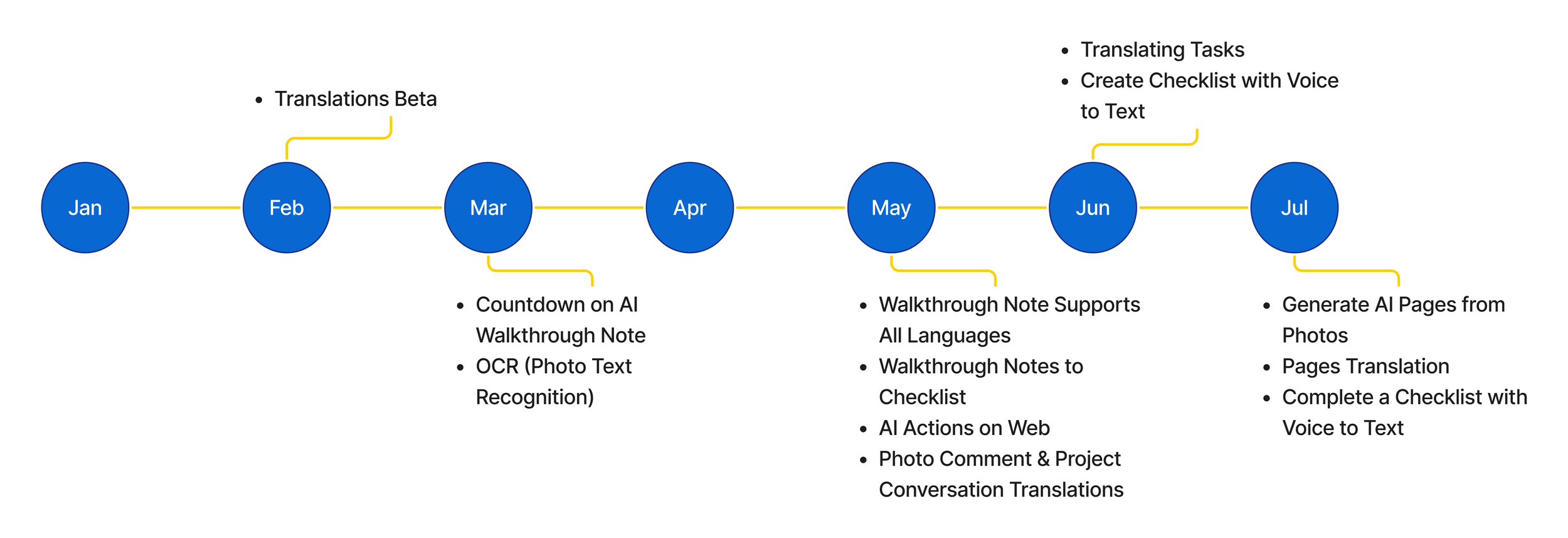
Case Study: From Sprints to Systems
Operationalizing Continuous Discovery at CompanyCam (Design and Product Operations)
Watch my talk on this case study from the 2025 DesignOps Summit here 🎥
🏗️ The Challenge
When I joined CompanyCam in 2023, discovery was happening—but unevenly.
Some teams ran usability tests, others did ad-hoc interviews, and many decisions were based on gut feel.
Tools like Dovetail existed, but they weren’t being used consistently.
There were no shared rituals, no connective tissue, and learning wasn’t visible.
The result? Rework, slow releases, and teams not always solving the most important customer problems.
🚀 First Breakthrough: Design Sprints
To spark momentum, I introduced Design Sprints as a low-lift catalyst.
Focus: Reimagining our Project Screen
Participants: Product, Design, Engineering, Sales, Success, Support, and leadership.
Outcomes:
Cross-functional alignment for the first time
5/5 post-sprint survey scores
Customer insights that influenced future designs
Demand for more sprints the very next month
The sprint was electric. People felt heard, energized, and saw discovery in action. But the buzz faded quickly. Discovery was still an event—not a habit.
📚 Continuous Discovery Habits Training
When a new VP of Product joined, he shared my conviction that discovery needed to scale. Together, we brought in Teresa Torres’ Continuous Discovery Habits (CDH) training.
Who: PMs, designers, engineers, and leaders trained together
What we learned:
Opportunity Solution Trees
Assumption mapping
Weekly customer touchpoints
Trio alignment as the core unit
The training built excitement, but when it ended, teams asked:
“Do I have the right meetings on my calendar? When should I involve stakeholders? What does a good version of this meeting look like?”
That’s when it clicked: training wasn’t enough—teams needed scaffolding.
🛠️ Building Scaffolding
Since I work in construction tech, I defined scaffolding in our context: Scaffolding is the temporary structure that provides support, safety, and access while the real work happens.
For us, scaffolding meant lightweight, repeatable structures—rituals, templates, and check-ins—that made discovery sustainable.
We called our approach “Just Enough Structure.”
Lightweight rituals: Try one new practice per quarter, retro, adjust.
Recommended touchpoints: Clarify when to involve data, marketing, or leadership—but let teams decide how.
Templates, not protocols: Tools teams could adapt, not cages they had to follow.
🎬 Scaffolding in Practice
Product Review: A biweekly session where trios shared a problem or stuck point in 5 minutes, followed by 5 minutes of feedback. To keep it fun (and short), we played Oscars-style play-off music when time was up. Teams loved it. It became the most valuable—and most talked about—meeting in the company.
Discovery Weekly: A dedicated ritual for trios (PM, Design, Engineering) + S3 (Sales, Success, Support). The goal: make learning visible, align on next steps, and invite collaboration. No prescriptive agenda—if Slack worked better than a meeting, that was fine. The outcome mattered more than the format.
Both rituals became the scaffolding teams needed: supportive, lightweight, and designed to fade into the background once habits stuck.
📈 Impact: Opportunity Size
With scaffolding in place, teams started sizing opportunities better.
Before: chasing grape-sized ideas that looked easy but had little impact.
After: focusing on watermelon-sized problems—the ones that gave customers a true sigh of relief when solved.
We asked ourselves regularly: “Is the juice worth the squeeze?”
📈 Impact: AI Acceleration
The biggest proof point showed up in our release cadence.
Before scaffolding: launches were sporadic, with long gaps between releases.
After scaffolding: teams released 10+ AI-powered features in just six months, with a steady monthly rhythm.
From scattered discovery to sustained delivery: scaffolding helped teams build and ship AI features with a steady monthly cadence. Sales enablement even had to create new ways to keep customer-facing teams updated, because releases were happening so fast they struggled to keep up.
📈 In just 6 months, 10+ AI features shipped. Scaffolding turned discovery from one-off sprints into a sustainable system of delivery.
🌱 Growing Without Bloat
Discovery became part of the rhythm of work.
Teams made faster, more confident decisions—not by cutting corners, but by validating sooner.
Trios worked as true units, not handoff machines.
Leadership had clearer visibility into why we were prioritizing opportunities.
And we did it without adding headcount. The change came from scaffolding, not scale.
✨ Lessons Learned
Training inspires, but scaffolding sustains.
Clarity beats complexity. Lightweight beats heavy.
Start small, scale by iteration. Pilots and retros, not mandates.
Cross-functional alignment is essential. Including S3 broke down silos and built trust.
💡 Reflection
This wasn’t about adding process for process’ sake. It was about creating the minimum viable operating model that let discovery thrive in a fast-moving, lean environment.
By moving from sprints —> scaffolding —> systems, we operationalized continuous discovery in a way that stuck—changing how CompanyCam built, learned, and scaled.
